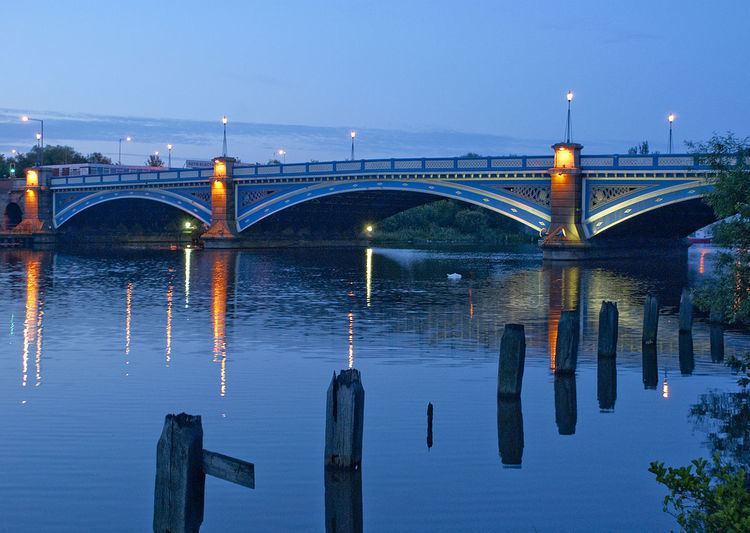Carries Bridge Road (A1130) Preceded by Tees Bridge Total length 104 m Body of water River Tees | Crosses River Tees Opened 20 June 1887 Width 18 m | |
 | ||
Locale Borough of Stockton-on-Tees, England, United Kingdom Official name Victoria Jubilee Bridge Heritage status Grade II listed building (19 February 2010) Address River Tees, United Kingdom Location Borough of Stockton-on-Tees Materials Wrought iron, Cast iron, Concrete Similar River Tees, Jubilee Bridge, Princess of Wales Bridge, Surtees Bridge, Teesquay Millennium Footbridge | ||
The Victoria Jubilee Bridge is a road bridge carrying Bridge Road (A1130) east west across the River Tees between Stockton-on-Tees and Thornaby-on-Tees in the borough of Stockton-on-Tees in the north east of England. Commonly referred to as the Victoria Bridge, it is located just south east of Stockton town centre.
Contents
Under an 1881 act of Parliament, the bridge was constructed (1882–1887) at a cost of £69,051 by Whitaker Brothers of Leeds, financed by the local council, a tramway company, North East Railways and the water board, and commemorates the 50th year of the reign of Queen Victoria.
History
Before the existence of a bridge at this location communication was provided by Bishop's Ferry. The first bridge was a five arch Stockton (stone) Bridge completed in 1771, designed by Joseph Robson of Sunderland and which was toll free by 1820.
Design
The design is a wrought-iron arch bridge by Charles Neate and consulting engineer Harrison Haytor. The foundations of the abutments and piers are five cylindrical columns, 40 feet (12 m) deep and 14 feet (4.3 m) in diameter. The abutments are faced with granite and sandstone and are filled in with large stone rubble. The bridge has three arches – the centre arch is 110 feet (34 m) wide and the side arches are 85 feet (26 m). The arches each have eight wrought iron ribs that vary in thickness from 3 feet (91 cm) at the centre to 4 feet (120 cm) at the bearings. The deck is carried on buckled plates resting on secondary beams. The road is 40 feet (12 m) wide and the pavement 10 feet (3.0 m) wide. The balustrades are cast iron with an open design of interlocking circles, and on the parapets are ornamental cast iron lampposts carrying modern lights while the spandrels are open cast iron work with a design of diminishing interlocking circles.
At either side of the bridge are land-based arches that are currently impassable on the upriver side. These were designed to allow horse-drawn barges to pass under the bridge.
Construction
Whitaker Brothers of Leeds began construction in 1882, and completed the bridge in 1887.
Operation
The bridge was opened on 20 June 1887 and replaced Yarm Bridge as the lowest bridge point on the river Tees. Shortly after the opening the tram system was extended over the bridge, and the bridge was to be used by trams until 1931. The bridge at this point was the lowest bridge point until the opening of the Middlesbrough Transporter Bridge in 1911 and the lowest permanent bridge point until the opening of the Tees Newport Bridge in 1934. During the second World War a bomb passed through the roadway without exploding and the bridge still bears schrapnel damage from the time. The bridge used to carry the A66 and A67 until the Surtees Bridge was built in 1981. In 2010 the bridge was made a grade II listed building.
